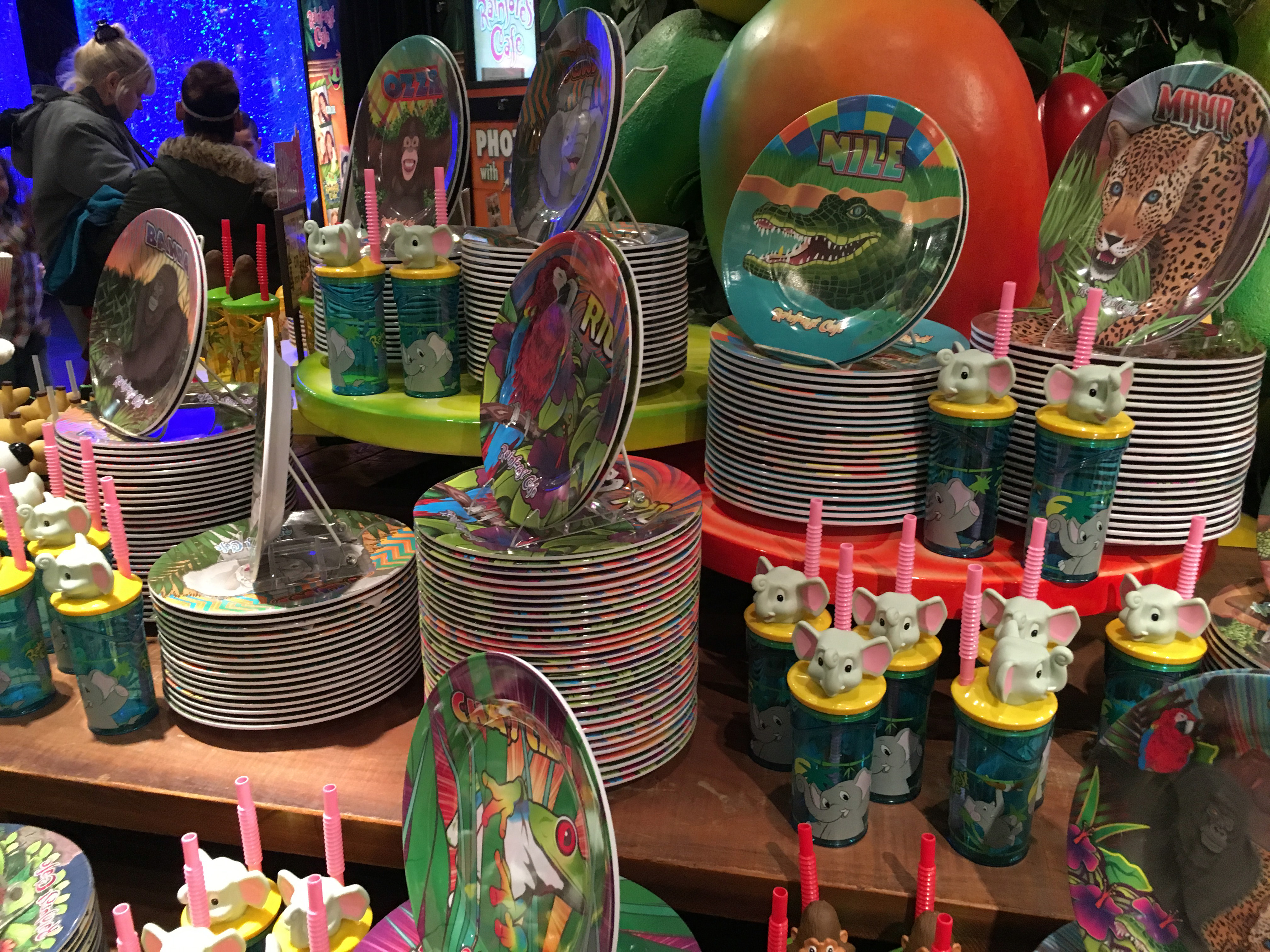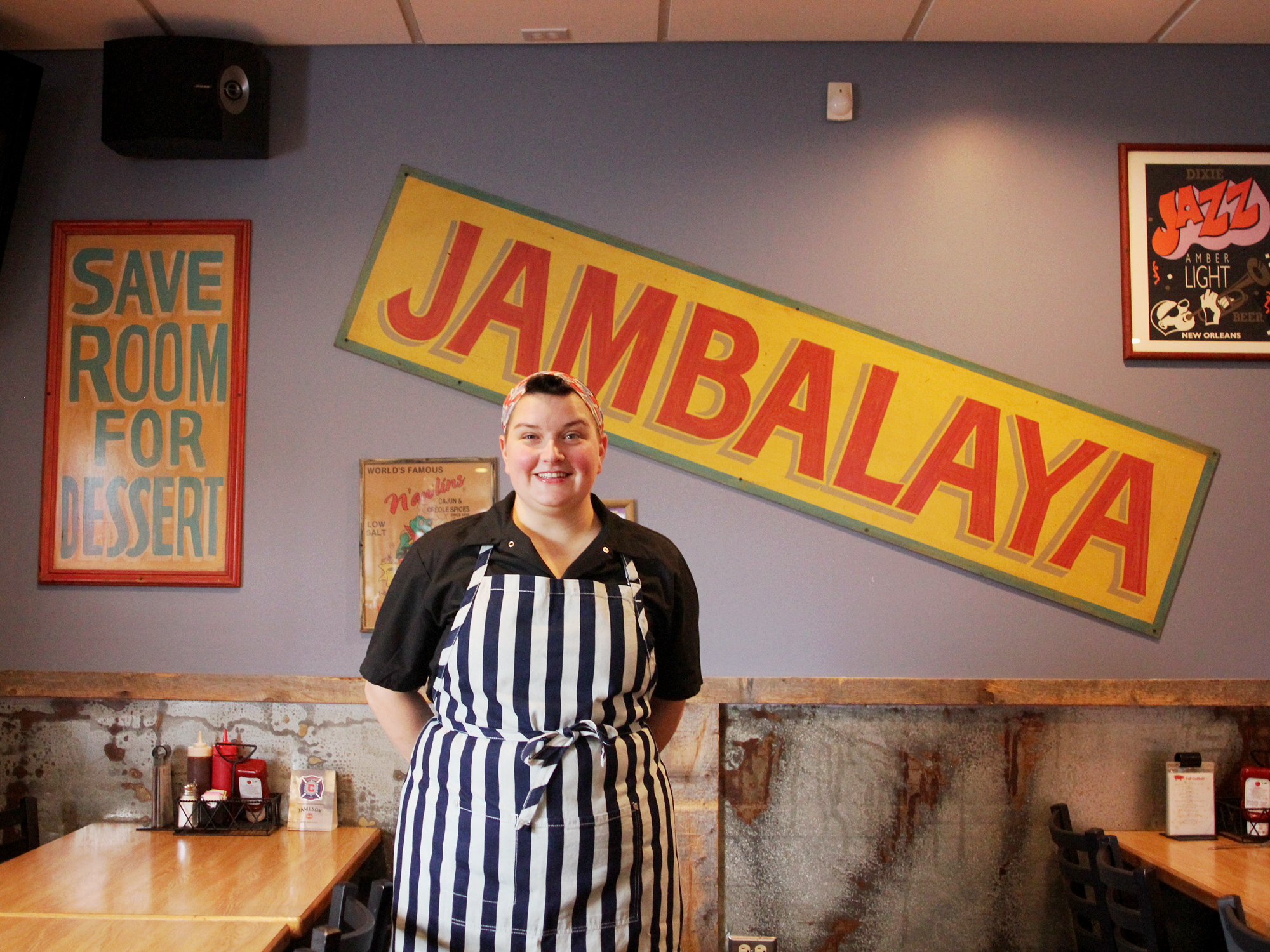ONE OFF HOSPITALITY (BLACKBIRD, AVEC, ETC.) HAS been one of the groups that helped feed the explosion of restaurants in the West Loop—they opened The Publican and Publican Quality Meats, and chefs like David and Anna Posey of Elske, who worked at Blackbird and The Publican, and Dan Snowden of Bad Hunter have come out of there.
But when the original chef to spin off of Blackbird was looking for a place to open his restaurant in 2004, the West Loop was a very different world. “In 2004, there wasn’t anything on Randolph,” Paul Virant says, as we meet for lunch at Vistro, his casual restaurant and bar in Hinsdale, where he lives.
“There were still a few residual restaurants from the mid to late 90s Randolph push—Marché, Red Light, Vivo—do you remember Toque?” he asks. (Barely, I have to admit.) “Both of the Sheerins worked at Toque; the chef, Mark Chmielewski, was my sous chef at Ambria.” (He’s now the chef of Latinicity.) “He left, and I was promoted to sous chef. But in ’04, that wasn’t a place that I would have looked at.”
Instead, Virant went west, to the comfortable, content suburb of Western Springs, to open Vie and preach the good gospel of 2000s food—farm to table, whole animal cooking, everything is better with pork. It worked—Vie was one of only two places in the suburbs to get a Michelin star, back when Michelin still went to the suburbs, and Virant was nominated four times for a James Beard award for Best Chef: Great Lakes. It’s been the one place in the ‘burbs taken seriously by city food writers throughout the past decade.
But you get the sense that Virant watched the food scene downtown explode, and itched to be part of it again. Which he soon will: sometime this summer or early fall, he’ll return to the West Loop to open Gaijin (a Japanese term for a foreigner, with a whiff of “yokel” or “barbarian” to it), a bar and restaurant focused on okonomiyaki, a Japanese savory pancake which he describes as being like pizza—you can do anything with the basic form. It will be located diagonally to the money-printing margarita machine Federales on Lake street, hoping to attract the West Loop scene for Japanese-styled drinks and food—not what Paul Virant was known for, last time he was in town.
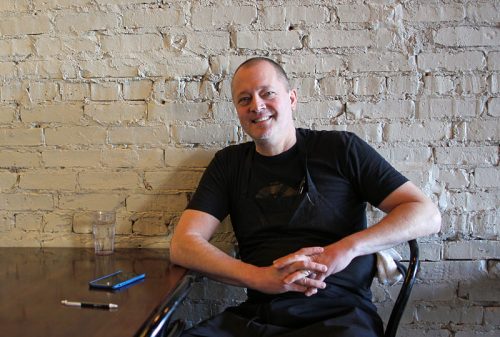
Paul Virant, at Vistro in Hinsdale
THERE WEREN’T MANY PEOPLE MORE IDENTIFIED with farm to table cooking and preserving good things from farmer’s markets than Paul Virant—he published a cookbook built around preservation in 2012. But chefs don’t have to follow the same currents in a straight line, and Japanese food has always been there in the background for the St. Louis native.
“My wife is a doctor, but she went to Duke undergrad and studied Japanese,” Virant explains. “She lived in a town near Osaka, which is the birthplace of okonomiyaki, and she fell in love with that dish. We started dating in 1996 and that’s when she introduced me to it—I was not aware of it at that time, I didn’t know what it was.
“It wasn’t until I started working on the business plan for Vie and started using a computer, which prior to that I didn’t use much. I started dabbling on the internet to try to find some information—there really wasn’t much out there,” he says. “One of the first recipes I found was from this website called Okonomiyaki World. It’s a Japanese site, but it talks about all the different okonomiyaki restaurants around the world—I think there’s some affiliation with the company OtaJoy in Hiroshima, which makes the okonomyaki sauce, the premade pancake batter. And I had Hiroko Shimbo’s book The Japanese Kitchen.”
There was one common ingredient in okonomiyaki that Virant had a natural affinity for—cabbage. “I love cabbage, just from working with [Everest chef Jean] Joho, and a grandmother on my mom’s side who was German. So I was exposed to sauerkraut when I was growing up. That has been part of the food at Vie for sure.
“But I tried it and thought, this is extremely versatile—I loved the idea of the okonomi part of the word, which means ‘have it your way,’ it’s like a customizable cabbage pancake. The original one I made was Osaka style, so you mix up the batter and the cabbage with the scallions, and you put that down on the griddle, and then you’re laying slices of bacon on the uncooked side. It became part of our family, something we would periodically do and make and dabble with. And we started talking about, this could be a cool restaurant.”
I like adding some of the midwestern meat repertoire, which is part of me, that I think Americans will appreciate. Keep the core traditional, but sort of Americanize it a little.
In fact, Virant first thought of suggesting an okonomiyaki stand for The J. Parker in the Hotel Lincoln, when Boka Group brought him in for Perennial Virant in 2012. “They just had a small griddle, which would have been perfect for okonomiyaki. But I don’t think Lincoln Park was the right place for it.”
Is Chicago the right place for it, even with the popularity of Asian food? Virant thinks so: “I think of it as a relatively healthy option—it’s craveable, it’s satiating. If you’re trying to eat healthy in the United States, it tastes healthy.” With the basic form as a pizza-like canvas, he plans to offer a mix of Japanese and American ingredients: “We’ll use the nagaimo, the mountain yam, grated into the stuff, we’re going to use seafood. But I like adding some of the midwestern meat repertoire, which is part of me, that I think Americans will appreciate. Keep the core traditional, but sort of Americanize it a little.”
One thing that definitely appeals to Virant is the Japanese tradition of pickling. “As a preservation guy, the Japanese tsukemono, all the different pickles they use, that has been fascinating to me. They’re fresher pickles, not super acidic or salty. I almost have to restrain myself as I’ve been learning about all the different pickles—the idea is to have something fresh to balance out the richness.
“So a few different Japanese inspired pickles, some traditional and then [some coming out of] my skills as a pickling guy, how my style is influenced by the Japanese,” Virant says.
Beyond okonomiyaki, Gaijin will have a bar program built around highballs, with some sakes, wines, and a beer brewed for them by Jared Rouben at Moody Tongue. The other draw will be kakigori, a Japanese shaved ice dessert—they’ve already ordered an expensive machine from Japan, capable of shaving blocks of ice into paper-thin strips which give the dessert its ethereal mouthfeel.
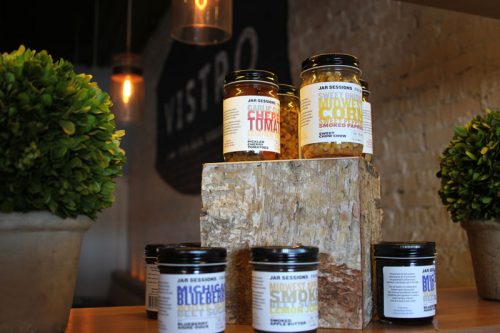
Vie’s pastry chef, Angelyne Canicosa, will make seasonal fruit syrups as well as ice creams which are placed in the middle of the mound of shaved ice—Virant has long bought up end of season fruit from his farmers to make use of through the off season in this way, including through his “Jar Sessions” brand of preserves. Canicosa will also make homemade sweetened condensed milk and milk jam for the desserts, as well as making and buying things like mocha pearls to decorate the desserts. “There’s definitely a whimsical component to some of Japan’s street food,” Virant says. “You go to the takoyaki place, there’s a big octopus out front. A lot of Americans, they don’t want to be reminded too much of that…”
Virant isn’t committed to a precise recreation of Japanese okonomiyaki, but he finds the richness of Japanese food culture an inspiration to draw on. He took his family for a ten day trip last year to Tokyo and Osaka, and his partner in Gaijin, Lance Richards, an executive with Wingstop, is there now. He hopes to go again before the restaurant opens, in part to shop for equipment (and to be sure he can get it serviced in the U.S.)—every table, for instance, will have a warming teppan set in it, to keep the okonomiyaki warm.
“As a gaijin, you’ve got to go to the source,” he says. “Go to the restaurants, see how they do it, check out everything—the ambience, the experience. Because Japanese street food is about the interaction, as much as anything.”
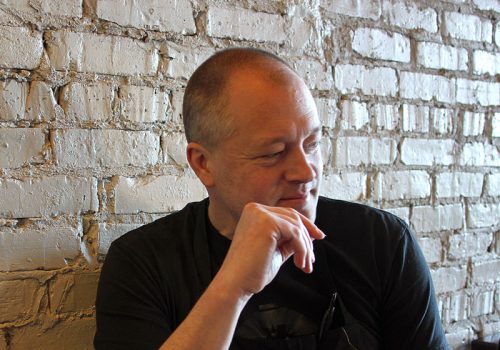
WHEN PAUL VIRANT WOUND UP OPENING a restaurant in the suburbs, they didn’t seem so far away from the hot food scene in the city. Le Français in Wheeling was regarded as a contender for the best restaurant in the country; Trio in Evanston was on a run of chefs that went from Rick Tramonto and Gale Gand, to Shawn McClain, to a kid named Grant Achatz.
Virant was working alongside Paul Kahan at Blackbird—”Vie” means life in French, but the name is also, in part, a nod to the fact that with two Pauls at the top of the kitchen, Virant was known as “V.” He and his wife lived in Ukrainian Village, and “we were looking at restaurant spaces on Division between Ashland and Western, we looked at the old Mas space,” where John Manion, now also in the West Loop (La Sirena Clandestina, El Che Bar), had been the chef. But at the time, she was working in west suburban Downers Grove, and with kids, the commute was taking its toll on the couple.
In the end they moved to Hinsdale for the commute and schools. “Everything shifted, and we met a few people” in the well-moneyed western suburbs. “Western Springs was a dry town, and they were looking for someone to have a liquor license for the first time,” he says. A chef straight from the acclaimed Blackbird downtown was just the person to open such a place, and so Vie opened in 2004.
Even so, Virant had to adjust to a different restaurant culture in the suburbs. “I think a lot of neighborhoods in Chicago deal with this too—we’re slammed on the weekends, but where’s everyone on Tuesday night?” he asks. “People are territorial. People live in Hinsdale, they want to know what’s available in Hinsdale. They want to walk down the street. [Vistro] opened in 2014—so Vie had been there for ten years. And I had people coming in, saying, I’m so glad you finally opened up a restaurant in Hinsdale. It’s two miles away! It’s a four minute drive,” he says, a bit incredulously.
To get by, “Vie has had to do Sunday suppers, and wine dinners, and barbecue week. Part of the success of Vie—because I was 34 when we opened—was having a distinguished older gentleman at the door, my father in law,” Al Tangora, a retired banker who served as Vie’s maitre’d for its first decade. “Because the customers were older, and I’m not from the area, my wife’s not from the area. People needed to see somebody that would legitimize us.”
The bigger surprise was that Vie, for all its success, didn’t lead to a wave of suburban destination dining. Dining has gotten more sophisticated in the once steak-and-potato suburbs, yet there’s at most only one other destination fine dining spot in the entire region outside the city, George Trois in Winnetka. Virant wonders if even Vie would be noticed if it opened now, with so much activity in the city.
So the idea of returning to the city has always been there; as early as 2008, when Vie was four years old, he was looking at spaces in the West Loop, including the location of a never-opened restaurant called Olo, which was nearly finished, with a wood-burning oven and other amenities, when the 2008 crash killed its funding. He was receptive when Ryan Poli left Perennial in 2012 and the Boka Group approached him about taking over the Perennial space, right across from the Green City Market, to which he was a frequent visitor.
His next move was opening Vistro in Hinsdale, but when Perennial Virant closed in 2016, he started looking for a space for the okonomiyaki restaurant, as well as somewhere to utilize the team from Perennial Virant. That closing, he says, “was hard on me but it was really hard on the staff, because my staff over at Perennial was so behind what we were doing, that we were right across from the Green City Market.” He looked at the Tete Charcuterie space, but it was a bit too big for the okonomiyaki concept, and instead he considered “Vie east,” another fine dining spot.
But okonomiyaki was the idea that stuck. “As one door closes, another opens,” he says in a moment of Zen. With the things he had once been an advocate for—farm to table, the goodness of pork—now the standard across the Chicago dining scene, being Paul Virant and opening a place downtown had to mean following your interests where they led next.
“I just thought, let’s do something different. Let’s do something new,” he says.
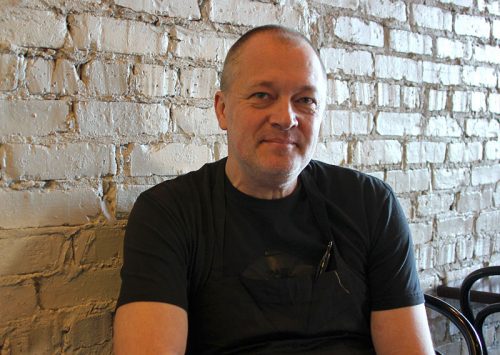
Michael Gebert sees a sky full of okonomiyaki as editor of Fooditor.
Latest
Join the Discussion
After you comment, click Post. If you're not already logged in you will be asked to log in or register with Disqus.






